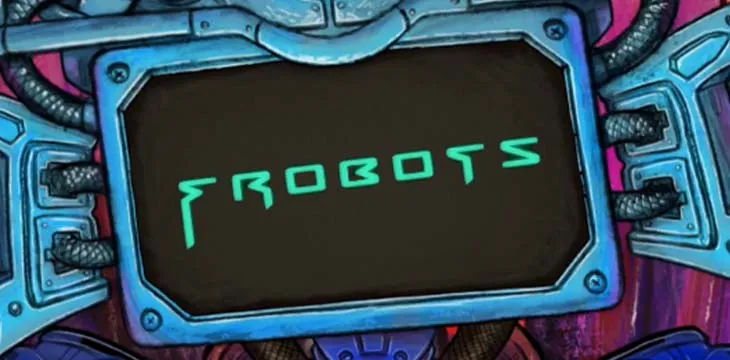|
Getting your Trinity Audio player ready...
|
In part IV of this “trilogy” series, I’d like to switch gears a bit, and instead of musing about how to build a successful NFT game theoretically, I’ll focus more on the current game that I am working on, FROBOTs.
This project has been a culmination of an idea bouncing around in my head for the last 3-4 years or so. It had its roots in the idea of distributed computing over blockchain. The same dream inspired Ethereum (except that they failed in their execution due to their fundamental design decisions). And it was shared by many computer science luminaries like Joe Armstrong, inventor of Erlang. If you recall, Bitcoin (the original Bitcoin, not BTC) has a subset of FORTH as its internal scripting language. Why would an electronic cash system need an internal scripting language if all it was supposed to do was just process payments of tokens from one party to another?
I don’t recall exactly when the idea of Bitcoin FORTH (or bFORTH) being an assembly language and the Bitcoin network being a CPU analog came to me, but when that clicked, all sorts of lightbulbs went off in my head at the same time. I am fairly sure it was due to something that Craig mentioned, perhaps his comments about Bitcoin validations being a perceptron or his comments about Wolfram 110 cellular automata—a Turing computer (albeit a very inefficient one), running ON Bitcoin.
My idea was that FORTH could be thought of as a “portable Assembly language” for the Bitcoin “distributed CPU” comprised of a distributed network of compute nodes running on Bitcoin, and the only thing missing was a suitable transpiler that could take a high-level language and compile it into Bitcoin transactions. Then programs can be executed broken up into units and distributed and executed piece-meal, and computations could be paid for atomically in these micro compute units, thereby achieving maximal efficiency in deployment and utilization of all available computation resources on the network. It would be a cloud compute solution without a central administrator such as AWS.
It’s not a new idea either, some other projects with equally lofty goals, such as Dfinity, started out to build something like this, but they fell to the dark side of incorporating a proprietary “app coin” that users needed to buy to use their network. (Which was always doomed to fail the way most ICO projects do).
However, after spending three months writing a small PoC for this idea, I realized there was little chance that there would be enough reason for any clients to use this distributed solution as a replacement for cloud compute. The benefits were not compelling enough, and the cost of re-adapting tooling and re-programming much of their workload was just too high.
But if not generic computation on blockchain, what other applications of blockchain compute may be palatable and exciting enough for the market to use and engage in?
Then I happened to catch up on reruns of my favorite spectator sport, Battlebots, and I thought, “EUREKA! That’s it! Combat coding! Battling virtual robots that you can create! I’ll create a Fanatical Universal Battling Autonomous Robot Simulator!” Though *I* thought the name of that was pretty fly, others around me thought that it was just a bit too cheeky (or was it geeky?), so I settled on FROBOTs instead.
What makes FROBOTs different? Well, it’s a kitchen sink of games. It is a competitive multiplayer game of skill and strategy. It isn’t turn-based, but it isn’t real-time either. It is educational, but it is also an esport. Competition is encouraged. Ingenuity is rewarded. It is a free market. It tests your ability to write code to drive a FROBOT that can destroy other players’ FROBOTS in a battle to the death. (Death is, well, not so big a deal for digital entities, so we will give them a pass). But the idea is fundamentally to outwit your opponents at a Battle Royale style game. But what puts skin-in-the-game from the perspective of the users is the fact that your FROBOTs will be NFTs.
What does this mean? Well, it doesn’t mean what you likely think it does. NFTs generally are seen as silly, frivolous, and trivial things that serve no other purpose than to act as a speculative vehicle for people who want to gamble on winning the ‘who’s the bigger fool,’ ‘collect the rare Pokemon’ game. FROBOTs NFTs are nothing like that. They won’t have value because they are rare or because they are some sort of status symbol. (Though I suppose that they may eventually become that).
No, they will have value because they have HISTORY.
What do I mean when I say ‘history’? Well, the easiest way to explain this is to use the analogy of a human. Take yourself. You are valuable. Nobody else is like you. Even if you are a twin, you are not the same person as your twin, and each of you is different. What makes you different is your history. Your record. If perfect human cloning technology were to exist today, and a copy of you were to be made1, even though both of you would believe you were the original, only one of you would have the scars and aged skin, bruises, and cataracts to show for it. It is how you got here, not just what you are now, that makes you who you are and comprises a large part of your value.
So FROBOTs, will embody this concept of digital assets provenance. A FROBOT can be created, traded, and destroyed, but a copy of it can never exist because even if one were to copy its brain code, it would not be able to copy its history. Its history would include who owned it at different times in the past, the records of matches that it participated in, and its brain code upgrade path and evolution. These are things that give each FROBOTs its uniqueness, its ‘scars,’ and character, and therefore its value.
So FROBOTs stands to be the first NFT application where the NFTs are actually agents themselves and not just property. Because unlike other NFTs, which are just pictures, or even ones that represent game characters such as those in Axie Infinity, NFTs represent just a ‘bag of attributes,’ game model, or game state. FROBOTs, on the other hand, encapsulates behavior, as it is CODE, not just static data. It does not require the human player to act through it. Instead, it acts in the game universe itself.
It is my belief that herein lies the true value of NFTs, the ability to give digital agents and entities their own autonomy, identity, and history. And I hope that with these three fundamental precepts, our FROBOTs will only ever grow more valuable with time, proof of work (history), and experience… just like people in the real world.
Jerry – Wall Street Technologist
Founder, FROBOTS.io
***
NOTE:
[1] Ala The Prestige with Hugh Jackman –
https://www.imdb.com/title/tt0482571/
Watch: The BSV Global Blockchain Convention panel, Metaverse, NFTs & Blockchain
https://www.youtube.com/watch?v=pf2LcdDLerQ

 09-18-2025
09-18-2025 





